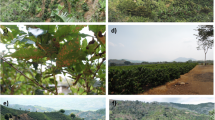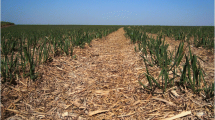Abstract
Growing Acacia albida as a permanent tree crop, on farmlands with cereals, vegetables and coffee underneath or in between, is an indigenous agroforestry system in the Hararghe highlands of Eastern Ethiopia. However, there is practically no systematic record or data on the merits and benefits of this practice.
The paper presents the results of an investigation into the effects of the presence of A. albida on farmlands on the yield of maize (Zea mays L.) and sorghum (Sorghum bicolor L. Moench). Twenty seven plot pairs each consisting of one plot underneath the A. albida foliage cover and the other in the open, away from the tree-on farmers' fields, in a 40 km radius around the Alemaya College of Agriculture, were sampled and the yield components analyzed. A statistically significant increase in crops yields by 56% on average was found for the crops under the tree canopies compared to those away from the trees. This increase was caused by the improvement in 1000 grain weight and number of grains of plants under the tree, indicating that the trees enhanced the fertility status of the soil and improved its physical conditions in terms of crop growth.
Additional benefits from the A. albida trees include supply of fuelwood and fodder. Quantitative estimates of these outputs as well as their monetary values are presented in the paper. However, in order to realize these benefits to a discernible extent, higher stand densities of the tree than at present are required.
Based on an enquiry about the farmers attitude towards A. albida, the prospects for an extension of this promising agroforestry technique are discussed against the background of the state and trends of development of agriculture in the area. It is surmised that despite some shortcomings like the relatively slow and highly variable growth of A. albida and a conflict with the spreading cultivation of Ch'at (Catha edulis Forsk.), the prospects of extension of this technique are good. It is recommended that its propagation should be incorporated into the programmes of the extension agencies of the various governmental agencies concerned with land use.
Similar content being viewed by others
References
Agro-economics Department (1980) Socio-economic study of the Legambo area mimeo. report, College of Agriculture, Alemaya
Charreau C and Vidal P (1965) Influence de l'Acacia albida Del. sur le sol, nutrition minerale et rendements des mils Pennisetum au Senegal. Agron Trop 6–7 pp 626–660
Dancette C and Poulain JF (1965) Influence of Acacia albida on pedoclimatic factors and crop yields. African Soils 14:1–2, 143–148
Dugain F (1960) Rapport de Mission au Niger. Centre de Pedologie de Nann-Dakar, mimeo. 22p
Felker P (1978) State of the Art: Acacia albida as a Complementary Permanent Intercrop with Annual Crops. University of California, Riverside, Calif, 133 p
Fisher RA (1970) Statistical Methods for Research Workers. 14th ed, Oliver and Boyd, Edinburgh
FAO/UNDAP (1982) Assistance to Land-Use Planning Project Reports. mimeo, Addis Ababa and Rome
Giffard PL (1964) Les possibilitiés de reboisement en Acacia albida au Senegal. Bois et Forets des Tropiques 95: 21–23
Jung G (1967) Influence de l'Acacia albida (del.) sur la biologie des sols dirr. Centre ORSTOM Dakar, Senegal, mimeo. 66 p
Miehe S. Acacia albida and other multipurpose trees on the Fur farmlands in the Jebel Marra highlands, Western Darfur, Sudan. Agroforestry Systems (in press)
Min of Agriculture (1974) A photogrametric assessment of 1966 E.C. harvest conditions in Eritrea, Tigre, Wollo, Northern Shoa and Hararghe. mimeo, Addis Ababa
Murphy HF (1959) A report on the fertility of some soils in Ethiopia. Imperial Ethiopian College of Agriculture and Mechanical Arts, Alemaya Exper Station Bulletin 1
Poschen P (1983) Status Report on On-going Agroforestry Research. mimeo. Plant Sc Dep, Alemaya College of Agriculture
Rehm S and Espig G (1976) Die Kulturpflanzen der Tropen und Subtropen. Ulmer, Stuttgart, FRG
Snedecor, GW (1956) Statistical Methods. 5th ed. Iowa State College Pr, Ames, USA
Tamirie Hawando (1982) Summary Results of Soil Science Research Program. mimeo, Plant Sc Dep Alemaya College of Agriculture
Author information
Authors and Affiliations
Rights and permissions
About this article
Cite this article
Poschen, P. An evaluation of the Acacia albida-based agroforestry practices in the Hararghe highlands of Eastern Ethiopia. Agroforest Syst 4, 129–143 (1986). https://doi.org/10.1007/BF00141545
Issue Date:
DOI: https://doi.org/10.1007/BF00141545




